This article needs additional citations for verification .(February 2015) |
Italian lira coins were the coins of the Italian lira that served as Italy's currency from 1861 until 2001 when it was replaced by the Euro.
This article needs additional citations for verification .(February 2015) |
Italian lira coins were the coins of the Italian lira that served as Italy's currency from 1861 until 2001 when it was replaced by the Euro.
From 1980 until 2001, Lira 1 and Lire 2 coins were struck solely for collectors due to their low value, and in 1998 the Lire 5 was also sold for collectors only. Lire 10 and Lire 20 coins dated 2000 or 2001 were struck in sets only. The Lire 500 coin was the first bimetallic circulating coin, and was also the first circulating coin to feature Braille numerals (a Braille "L. 500" is on the upper rim of the coin's reverse, above the building).
| Value | Image | Specifications | Description | Minted | Usage | Common Reference | ||||||
|---|---|---|---|---|---|---|---|---|---|---|---|---|
| Obverse | Reverse | Diameter | Thickness | Mass | Composition | Edge | Obverse | Reverse | ||||
| c.1 | 15 mm | 0.78mm | 1 g | Bronze | (1861-1918) | |||||||
| c.2 | 20 mm | 0.8mm | 2 g | Bronze | (1861-1917) | |||||||
| c.5 | 25 mm (1861-1918), 19.5 mm (1919-1943) | 1.08mm | 5 g (1861-1918), 3.25 g (1919-1939), 2.95g (1939-1943) | Bronze (1861-1939), Aluminum-bronze (1939-1943) | (1861-1943) | |||||||
| c.10 [1] [2] | 30 mm (1862-1867), 30.5 mm (1893-1894), 30 mm (1911), 22.5 mm (1919-1943) | 1.50mm | 10 g (1862-1911), 5.4 g (1919-1939), 4.7 g (1939-1943) | Bronze (1862-1939) Aluminum-bronze (1939-1943) | (1862-1943) | |||||||
| c.20 | 1.53mm | Silver 1863-67 Copper-nickel 1894–95, 1918–20 Nickel 1908-38 Stainless steel 1939-43 | 1863-1943 | |||||||||
| c.25 | ||||||||||||
| c.50 | Silver 1861-1892 Nickel 1919-38 Stainless steel 1939-43 | 1862-1943 | ||||||||||
| Lira 1 | Silver 1862-1917 Nickel 1922-38 Stainless steel 1939-43 Aluminum 1946–70, 1980-2001 | 1862–1970, 1980-2001 | ||||||||||
| Lire 2 | Silver 1862-1917 Nickel 1923-39 Stainless steel 1939-43 Aluminum 1946–70, 1980-2001 | 1862–1970, 1980-2001 | ||||||||||
| Lire 5 | Silver 1862-1941 Gold 1863-65 [3] Aluminum 1946-2001 | 1862-2001 | ||||||||||
| Lire 10 | Aluminum | 1951-2001 | ||||||||||
| Lire 20 | Aluminum-bronze 1957–59, 1968-2001 | 1957-2001 | ||||||||||
| Lire 50 | Stainless steel 1954-95 Copper-nickel 1996-2001 | 1954-2001 | ||||||||||
| Lire 100 | Stainless steel 1955-92 Copper-nickel 1993-2001 | 1955-2001 | ||||||||||
| Lire 200 | Aluminum-bronze | 1977-2001 | ||||||||||
| Lire 500 | Silver 1958-2001 Bi-metallic aluminum-bronze center in stainless steel ring, 1982-2001 | 1958-2001 | ||||||||||
| Lire 1000 | Bi-metallic copper-nickel centre in aluminum-bronze ring | 1997-2001 | ||||||||||
| 1 Italian lira 1863 | |
|---|---|
 | |
| Vittorio Emanuele II | Coat of arms of the House of Savoy |
| 200 Italian lire Montessori | |
|---|---|
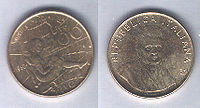 | |
| FAO's celebration | Maria Montessori |

The birr is the primary unit of currency in Ethiopia. It is subdivided into 100 santims.

The lira was the currency of Italy between 1861 and 2002. It was introduced by the Napoleonic Kingdom of Italy in 1807 at par with the French franc, and was subsequently adopted by the different states that would eventually form the Kingdom of Italy in 1861. It was subdivided into 100 centesimi, which means "hundredths" or "cents". The lira was also the currency of the Albanian Kingdom from 1941 to 1943.
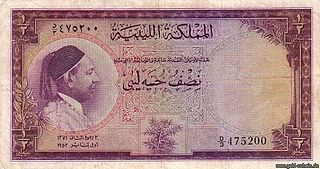
The Libyan pound was the currency of Libya between 1951 and 1971. It was divided into 100 piastres and 1000 milliemes (مليم).

The scudo was the name for a number of coins used in various states in the Italian peninsula until the 19th century. The name, like that of the French écu and the Spanish and Portuguese escudo, was derived from the Latin scutum ("shield"). From the 16th century, the name was used in Italy for large silver coins. Sizes varied depending on the issuing country.
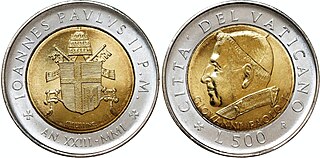
The lira was the currency of the Vatican City between 1929 and 2002. It was not a separate currency but an issue of the Italian lira; the Banca d'Italia produced coins specifically for Vatican City.

The lira was the currency of San Marino from the 1860s until it was replaced by the euro on 1 January 2002. It was equivalent and pegged to the Italian lira. Italian coins and banknotes and Vatican City coins were legal tender in San Marino, while Sammarinese coins, minted in Rome, were legal tender throughout Italy, as well as in the Vatican City.

The Somalo was the currency of the Trust Territory of Somaliland administered by Italy between 1950 and 1960. The "Somalo" remained officially in use in the newly created Somali Republic until 1962. It was subdivided into 100 centesimi.

The lira was the currency of the Kingdom of Sardinia between August 6, 1816, and March 17, 1861.
The lira austriaca was the currency of the Kingdom of Lombardy–Venetia.

The lira was the currency of the Papal States between 1866 and 1870. It was subdivided into 20 soldi, each of 5 centesimi.

The Italian East African lira was a special banknote circulating in Italian East Africa between 1938 and 1941.
The lira was the distinct currency of Venice until 1848, when it was replaced by the Italian lira. It originated from the Carolingian monetary system used in much of Western Europe since the 8th century CE, with the lira subdivided into 20 soldi, each of 12 denari.
The scudo was the currency of Milan until 1806. It was subdivided into 6 lire, each of 20 soldi or 240 denari.

The Italian Somaliland lira also called the Somali lira, was a special version of the Italian lira minted in Italian Somaliland between 1925 and 1926.
The lira was the currency of the Republic of Lucca until 1800 and again of the Duchy of Lucca between 1826 and 1847. It was subdivided into 20 soldi, each of 3 quattrini or 12 denari.
The lira was the currency of the mainland part of the Kingdom of the Two Sicilies, known as the Kingdom of Naples, between 1812 and 1813.
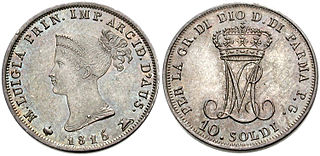
The lira was the distinct currency of Parma before 1802 and again from 1815 to 1859.
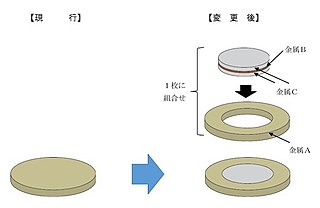
Bi-metallic coins are coins consisting of two (bi-) metals or alloys, generally arranged with an outer ring around a contrasting center. Common circulating examples include the €1, €2, United Kingdom £1 and £2, Canadian $2, South Africa R5, Turkish 1 lira and 50 kurus, Indian ₹10 and ₹20, Indonesian Rp1,000, Polish 2 and 5 zł, Czech 50 Kč, Hungarian 100 and 200 Ft, Bulgarian 1 and 2 lv., Hong Kong $10, Argentine $1 and $2, Brazilian R$1, Chilean $100 and $500, Colombian $500 and $1000, Peruvian S/2 and S/5, Albanian 100 Lekë, and all Mexican coins of $1 or higher denomination.

The AM-lira was the currency issued in Italy by Allied Military Government for Occupied Territories (AMGOT) after the Allied invasion of Sicily in 1943. 100 AM-lire were worth 1 US dollar.

Italy has a long history of different coinage types, which spans thousands of years. Italy has been influential at a coinage point of view: the medieval Florentine florin, one of the most used coinage types in European history and one of the most important coins in Western history, was struck in Florence in the 13th century, while the Venetian sequin, minted from 1284 to 1797, was the most prestigious gold coin in circulation in the commercial centers of the Mediterranean Sea.